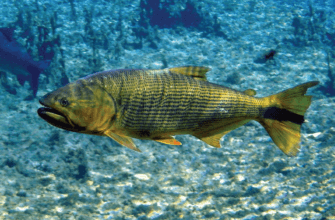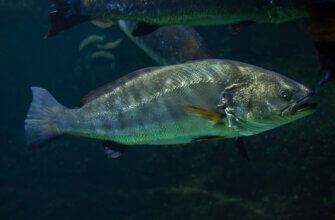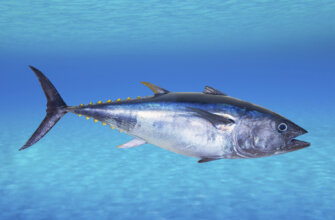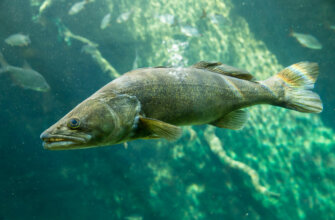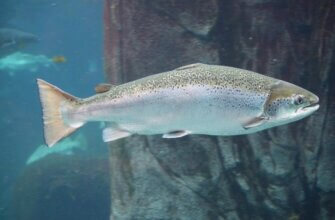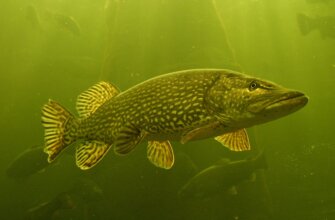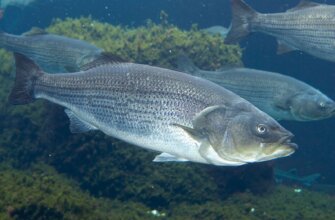Pacu is a freshwater fish species that belongs to the Characidae family. They are native to South America and can be found in rivers, streams, and lakes in Brazil, Paraguay, and Argentina. They are popular among anglers and aquarists due to their size, strength, and beauty.
Pacu has a similar body shape to that of the Piranha, but they have flat teeth that are used for crushing hard nuts and seeds. Pacu can grow to be quite large, with some individuals reaching over 3 feet in length and weighing over 50 pounds.
Pacu is omnivorous, and their diet includes fruits, nuts, seeds, and small aquatic animals like insects and small fish. In captivity, they can be fed a variety of commercial fish feeds, fruits, and vegetables.
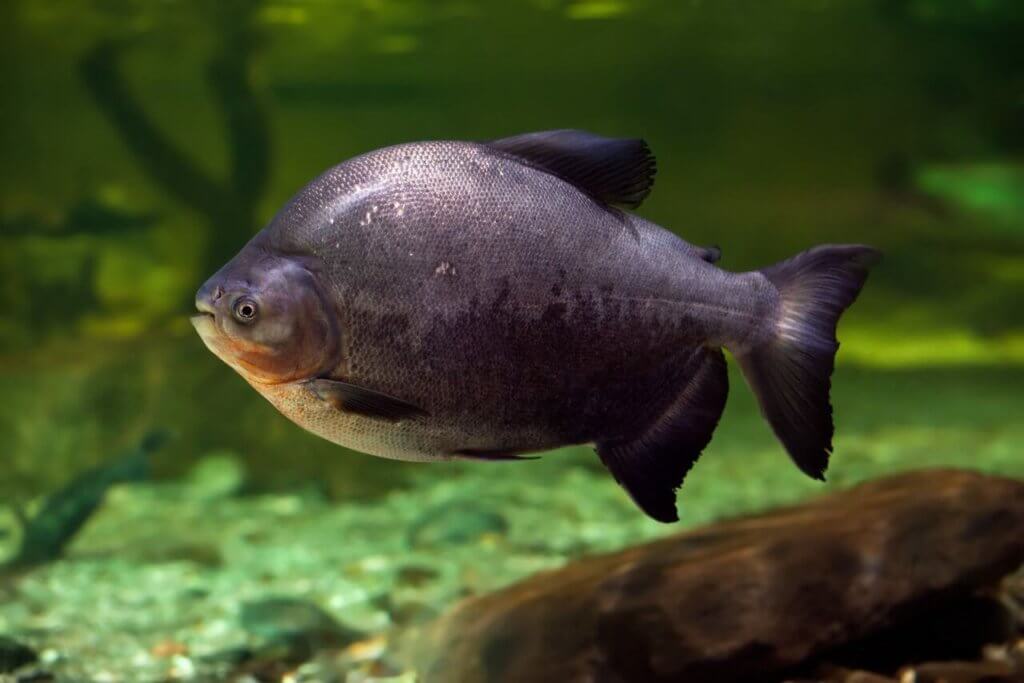
Pacu is known for its powerful and acrobatic fights when caught by anglers. They are often caught using live bait, such as worms or small fish, and are a popular game fish in many South American countries. Pacu is also kept in home aquariums, although they require a large tank and proper filtration due to their size and waste production.
It’s important to note that Pacu can be an invasive species in some areas outside their native range, and they can cause damage to local ecosystems. As such, it’s important to check the local regulations before introducing Pacu to any new water systems.
Species
The term “Pacu” refers to several species of freshwater fish that belong to the Characidae family.
Here are some of the most common species of Pacu:
- Red-bellied Pacu (Piaractus brachypomus). This species of Pacu is native to the Amazon and Orinoco river basins. It is a large and powerful fish that can grow up to 3 feet in length and weigh over 50 pounds. The Red-bellied Pacu is an omnivore that feeds on a variety of fruits, nuts, seeds, and small aquatic animals.
- Black Pacu (Colossoma macropomum). The Black Pacu is another species of Pacu that is native to the Amazon basin. It is a large fish that can grow up to 3.3 feet in length and weigh over 80 pounds. The Black Pacu is also an omnivore that feeds on fruits, nuts, seeds, and small aquatic animals.
- Tambacu (Piaractus mesopotamicus x Colossoma macropomum). The Tambacu is a hybrid of two Pacu species, the Piaractus mesopotamicus and the Colossoma macropomum. It is a popular game fish in Brazil and can grow up to 3.3 feet in length and weigh over 80 pounds. The Tambacu is also an omnivore that feeds on fruits, nuts, seeds, and small aquatic animals.
- Spotted Pacu (Piaractus brachypomus x Piaractus mesopotamicus). The Spotted Pacu is a hybrid of the Red-bellied Pacu and the Piaractus mesopotamicus. It is a popular game fish in South America and can grow up to 2.5 feet in length and weigh over 30 pounds. The Spotted Pacu is also an omnivore that feeds on fruits, nuts, seeds, and small aquatic animals.
It’s important to note that there are other species of Pacu as well, and their characteristics and behaviors can vary depending on their species, environment, and genetics.
Appearance
Pacu has a similar body shape to that of the Piranha, with a high, laterally compressed body and a blunt head. However, Pacu can be distinguished from Piranha by its blunt teeth, which are used for crushing hard nuts and seeds, rather than for tearing flesh.
Pacu can vary in coloration, depending on their species, age, and environment. Some species of Pacu, such as the Red-bellied Pacu, have a reddish-brown coloration on their upper body and silvery-white coloration on their lower body. Others, such as the Black Pacu, have a dark gray or black coloration on their upper body and silvery-white coloration on their lower body. Some Pacu species may also have spots or stripes on their body.
Pacu can grow to be quite large, with some individuals reaching over 3 feet in length and weighing over 50 pounds. As such, they require a large tank if kept in home aquariums. In the wild, Pacu can be found in rivers, streams, and lakes in South America.
Size and weight
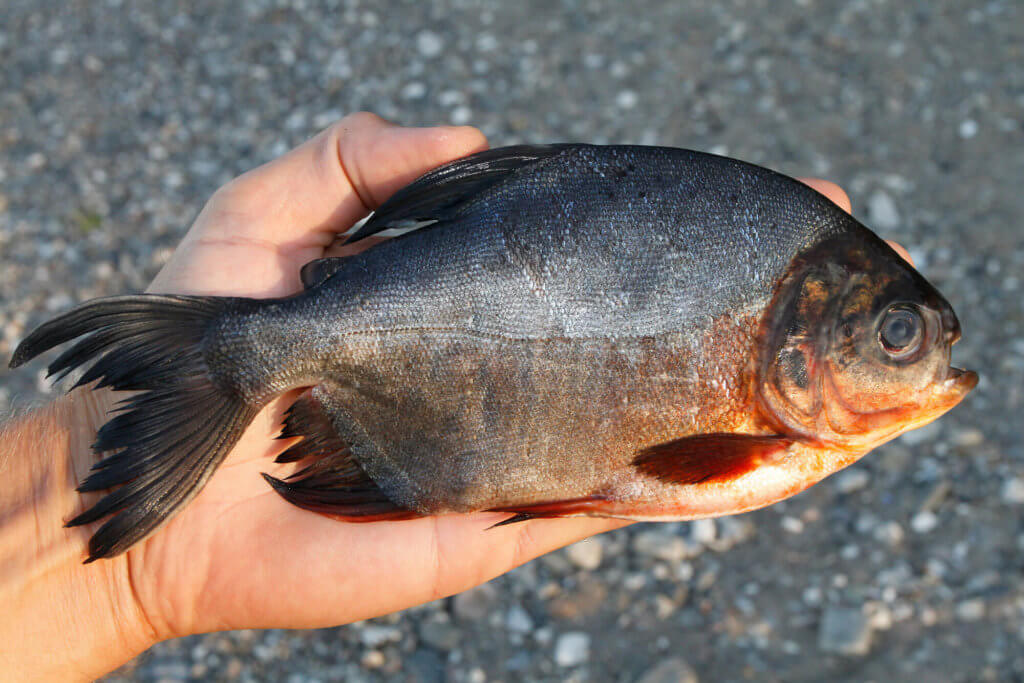
Pacu can grow to be quite large, with some individuals reaching over 3 feet in length and weighing over 50 pounds. The Red-bellied Pacu, for example, can grow up to 3 feet in length and weigh over 50 pounds, while the Black Pacu can grow up to 3.3 feet in length and weigh over 80 pounds.
The size and weight of Pacu can vary depending on their species, age, and environment. In general, Pacu that are raised in captivity tend to grow larger and faster than those in the wild, as they have access to a constant supply of food and optimal living conditions. However, it’s important to note that Pacu are large fish that require a lot of space, both in the wild and in captivity. If you are considering keeping Pacu in a home aquarium, you should make sure that you have a large enough tank to accommodate their size and provide them with adequate swimming space.
Diet
Pacu are omnivorous, which means that they eat both plant and animal matter. In the wild, their diet primarily consists of fruits, nuts, seeds, and aquatic vegetation, although they may also feed on small fish and invertebrates.
In captivity, Pacu can be fed a variety of different foods, including commercial fish food pellets, fruits, vegetables, and nuts. It’s important to make sure that their diet is well-balanced and provides them with all of the necessary nutrients that they need to stay healthy.
One thing to note about Pacu is that they have very strong teeth, which are designed for crushing hard nuts and seeds. As such, it’s important to provide them with foods that are appropriate for their dental structure. Some Pacu owners have reported that their fish have damaged their teeth by eating hard objects, such as aquarium decorations, so it’s important to provide them with a well-rounded diet that includes appropriate food items.
Behavior
Pacu are generally peaceful and social fish, and they are known for their curious and playful behavior. They are active swimmers and require plenty of space to move around, both in the wild and in captivity.
In the wild, Pacu are known for their ability to jump out of the water, particularly during the breeding season. They are also known for their strong swimming ability and can swim against strong currents.
In captivity, Pacu are often kept in groups, as they are social fish that thrive in the company of their own species. However, it’s important to make sure that their tank is large enough to accommodate the size of the group and that there is plenty of swimming space for each fish.
It’s also important to note that Pacu are large and powerful fish, and they can be destructive to their environment if their tank is not properly maintained. They require a well-filtered tank with plenty of water flow, as well as regular water changes to maintain good water quality.
Spawning
Pacu are known to breed in the wild during the rainy season when water levels rise and temperatures increase. During this time, males will compete for females by displaying their colors and engaging in courtship behaviors.
In captivity, breeding Pacu can be challenging, as they require very specific conditions to reproduce. It’s important to make sure that the tank is large enough to accommodate the breeding pair and that the water conditions are optimal, including the temperature and pH levels.
When breeding Pacu in captivity, it’s important to provide them with a spawning site, such as a flat surface or a breeding cone, where they can lay their eggs. After spawning, the male will fertilize the eggs, and the female will guard them until they hatch.
It’s important to note that Pacu can produce a large number of eggs, which can lead to overcrowding if all of the eggs hatch successfully. If you are considering breeding Pacu in captivity, it’s important to have a plan in place for the care of the offspring, including providing them with adequate space and food.
Fishing
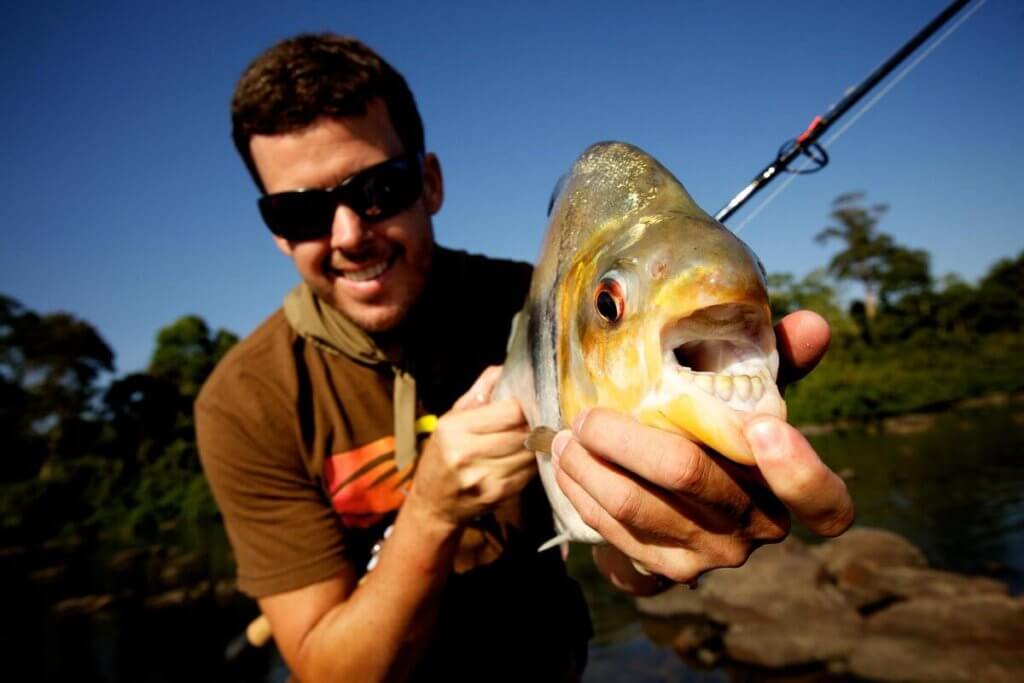
Pacu are popular game fish and are sought after by anglers for their large size and fighting ability. They can be caught using a variety of fishing techniques, including bait fishing, fly fishing, and lure fishing.
When targeting Pacu, it’s important to use the right equipment, as they are powerful fish that can put up a strong fight. A heavy-duty fishing rod and reel with a high line capacity are recommended, as well as a strong fishing line with a high breaking strength.
In terms of bait, Pacu are known to feed on a variety of different foods, including fruits, nuts, and seeds. Anglers have had success using a variety of baits, including bread, corn, and fruit-flavored baits.
When lure fishing for Pacu, it’s important to use lures that mimic their natural prey. Small crankbaits, spinners, and jigs can all be effective, as well as fly fishing lures such as streamers and poppers.
It’s important to note that Pacu are a popular food fish in many parts of the world, and regulations regarding the catch and release of Pacu may vary depending on your location. Always check your local fishing regulations before targeting Pacu, and practice responsible catch and release practices to ensure the sustainability of the fishery.
Lures
When fishing for Pacu, there are a variety of lures that can be effective. Pacu are omnivorous and will feed on a variety of different foods, including fruits, nuts, and seeds. As such, many Pacu lures are designed to mimic these types of food.
One popular type of Pacu lure is the fruit-flavored soft plastic lure. These lures are designed to look and smell like pieces of fruit, and can be fished with a slow, steady retrieve. Another effective lure is the spoon lure, which can be fished using a variety of techniques, including casting and trolling.
Spinnerbaits can also be effective when fishing for Pacu. These lures feature a spinning blade that creates vibration and flash in the water, which can attract the attention of feeding fish. Jigs can also be effective when targeting Pacu, as they can be fished at a variety of depths and can be tipped with a variety of different baits, including worms and grubs.
It’s important to note that when using lures for Pacu, it’s important to match the size and color of the lure to the conditions you are fishing in. If the water is clear and calm, a smaller, more natural-looking lure may be more effective, while in murky or fast-moving water, a larger, brighter lure may be more visible to the fish.
Here are a few examples of fishing lures for Pacu, along with their models and specifications:
- Yo-Zuri 3D Inshore Twitchbait. This lure is designed to mimic small baitfish, and features a realistic 3D finish and internal holographic foil. It is 4 inches long, weighs 7/16 ounces, and has a slow-sinking action.
- Rebel Pop-R. This topwater popper features a cupped lip that creates a popping sound and splash when retrieved, which can attract the attention of Pacu. It is 3 inches long, weighs 1/4 ounce, and can be retrieved at a variety of speeds.
- Heddon Super Spook Jr. This walking bait features a realistic finish and a walking action that mimics a fleeing baitfish. It is 3 1/2 inches long, weighs 1/2 ounce, and can be retrieved with a steady walking motion.
- Bomber Saltwater Grade Badonk-A-Donk. This topwater plug features a rattling chamber and a weight transfer system that allows for long casts. It is 3 1/2 inches long, weighs 3/4 ounces, and can be retrieved with a steady popping motion.
- Mepps Aglia Spinner. This spinnerbait features a brass blade that creates vibration and flash in the water, as well as a dressed treble hook that mimics the appearance of a small baitfish. It is available in a variety of sizes and colors, and can be fished using a variety of techniques, including casting and trolling.
Baits

Pacu are omnivorous and will feed on a variety of different foods, including fruits, nuts, and seeds, as well as insects, crustaceans, and small fish. As such, there are many different baits that can be effective when targeting Pacu.
One of the most popular baits for Pacu is fruit. Pieces of ripe fruit, such as bananas, peaches, and watermelon, can be fished on a hook and cast into the water. These baits can be particularly effective in areas where there are overhanging trees or other vegetation that drops fruit into the water.
Another effective bait for Pacu is nuts, such as pecans and peanuts. These baits can be fished on a hook with a split shot weight, and can be cast into the water near areas of cover or structure, such as fallen trees or rock piles.
Live baits, such as worms, crickets, and small minnows, can also be effective when targeting Pacu. These baits can be fished on a hook under a bobber, or on a jighead with a slow, steady retrieve.
It’s important to note that when using baits for Pacu, it’s important to match the size and type of bait to the conditions you are fishing in. If the water is clear and calm, a smaller, more natural-looking bait may be more effective, while in murky or fast-moving water, a larger, more visible bait may be more attractive to the fish.
Here are a few examples of fishing baits for Pacu, along with their models and specifications:
- Berkley Gulp! Alive! Waxies. These artificial baits mimic the scent and texture of real wax worms, which can be an effective bait for Pacu. They are available in a variety of colors and can be fished on a hook with a slow, steady retrieve.
- Pecans. Pecans are a natural bait that can be effective for Pacu, particularly in areas where there are overhanging trees. Simply crack open a few pecans and fish them on a hook with a split shot weight.
- Live Crickets. Crickets are a popular bait for Pacu, as they are readily available and easy to use. They can be fished on a hook under a bobber or on a jighead with a slow, steady retrieve.
- Small Minnows. Small minnows can be an effective bait for Pacu, particularly when fished near areas of cover or structure. They can be fished on a hook with a split shot weight or on a jighead with a slow, steady retrieve.
- Watermelon Chunks. Watermelon is a favorite food of Pacu, and fishing chunks of watermelon on a hook can be an effective way to catch them. These baits can be fished on a hook with a split shot weight, or on a jighead with a slow, steady retrieve.
Rods
When it comes to fishing for Pacu, it’s important to use a rod that is strong enough to handle the fish’s size and power. A medium-heavy to heavy-action spinning or baitcasting rod with a fast tip is a good choice for targeting Pacu.
The rod should be at least 7 feet long, as this will provide enough leverage to fight the fish and help prevent it from breaking the line. The rod should also have a high line weight rating, as Pacu can grow quite large and put up a strong fight.
Some features to look for in a Pacu fishing rod include:
- Strong blank. The rod should have a strong blank made from a high-quality material like graphite or fiberglass. This will provide the strength and durability needed to handle large Pacu.
- Fast action. A fast-action rod with a sensitive tip will provide the angler with the ability to feel the bite and set the hook quickly.
- High line weight rating. The rod should have a high line weight rating, at least 20-30 pounds, to handle the weight and power of the Pacu.
- Comfortable handle. A comfortable handle is important when fighting a strong fish like the Pacu. Look for a rod with a comfortable handle made from cork or EVA foam.
- Reel seat. The rod should have a strong reel seat that can securely hold the reel in place during the fight.
Examples of fishing rods that are suitable for Pacu include the Penn Carnage II Surf Spinning Rod, the St. Croix Avid Series Casting Rod, and the Shimano Teramar TMS-X70MH Spinning Rod.
Here are some examples of fishing rods that are suitable for Pacu with their models and specifications:
- Penn Carnage II Surf Spinning Rod – Model: CARIISS1220S80, Length: 8′, Power: Heavy, Action: Fast, Line Weight: 20-40 lbs, Lure Weight: 2-6 oz
- St. Croix Avid Series Casting Rod – Model: AVC70HF, Length: 7′, Power: Heavy, Action: Fast, Line Weight: 15-30 lbs, Lure Weight: 1-4 oz
- Shimano Teramar TMS-X70MH Spinning Rod – Model: TMS-X70MH, Length: 7′, Power: Medium-Heavy, Action: Extra Fast, Line Weight: 10-20 lbs, Lure Weight: 1/2-1 1/2 oz
- Ugly Stik Tiger Elite Jig Spinning Rod – Model: USESPJ710MH, Length: 7’10”, Power: Medium-Heavy, Action: Fast, Line Weight: 20-50 lbs, Lure Weight: 3/4-6 oz
- Okuma Cedros CJ-65S Spinning Rod – Model: CJ-65S, Length: 6’6″, Power: Heavy, Action: Fast, Line Weight: 40-80 lbs, Lure Weight: N/A
It’s important to note that the right fishing rod for Pacu will depend on a variety of factors, including personal preference and the specific fishing location. Always choose a rod that is strong enough to handle the size and power of the fish you’re targeting.
Dishes
Pacu is a freshwater fish that is commonly found in South America and is known for its mild, sweet-tasting flesh.
Here are some dishes that can be made with Pacu:
- Grilled Pacu. This is a simple and flavorful way to prepare Pacu. The fish is marinated in a mixture of lemon juice, olive oil, garlic, and herbs, and then grilled until it is cooked through and slightly charred.
- Pacu Ceviche. Ceviche is a popular dish in Latin America that typically consists of raw fish marinated in citrus juice. For Pacu ceviche, the fish is first cooked, and then mixed with lime juice, cilantro, red onion, and diced tomatoes.
- Pacu Fish Stew. This hearty stew is made with Pacu, tomatoes, onions, garlic, and bell peppers, along with a variety of herbs and spices. The fish is cooked in the stew until it is tender and flaky.
- Fried Pacu. This is a popular way to prepare Pacu in Brazil. The fish is seasoned with salt and pepper, coated in flour or cornmeal, and then fried until crispy and golden brown.
- Pacu with Coconut Milk. This dish combines Pacu with coconut milk, ginger, garlic, and curry powder to create a rich and flavorful curry. The fish is cooked in the sauce until it is tender and flaky, and then served over rice.

